With a significant victory in New England, the IBEW announced a new era in outside construction organizing.
JCR Construction, one of the Northeast's largest nonunion transmission line contractors, had been the target of unsuccessful organizing attempts for decades. But since the 2016 International Convention, the way the IBEW organizes new members and new companies has been changing.
"When I say we are making this brotherhood into an organizing union again, that doesn't just mean locals organizing more. I mean we'll use all the resources at our disposal in a coordinated fashion to maximize our success," said International President Lonnie R. Stephenson.
Director of Membership Development for Outside Construction Ed Mings began the latest JCR campaign a year ago as the first director-level outside organizing specialist in nearly two decades. Since then, he and Special Assistant to the International President for Membership Development Ricky Oakland have worked to bring the overwhelmingly successful new organizing model from the professional and industrial and inside construction sectors to the outside as well.
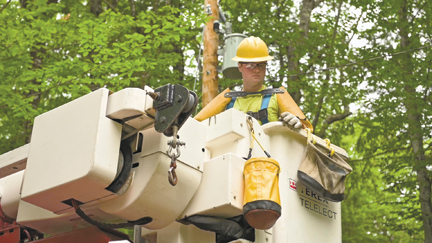
|
| JCR was the first of multiple campaigns launched in the last year, with targets in the Carolinas, Texas, Missouri, Florida and everywhere in between.
|
"Our market share is down to 35% and International President Stephenson said, 'We have to organize this branch,'" Oakland said. "As a brotherhood, we have the resources, but we have to be smart about how we attack this. The locals know the workers, the contractors and the work. The international organization brings coordination and leverage."
At stake is a fundamental battle to regain power in an industry that is in a gold rush.
Renewables like wind and solar are being built at a record pace. The high-voltage transmission lines connecting them to population centers are the main bottleneck to faster expansion. Distributed generation that sends power into the grid from every direction requires radically rebuilding distribution networks. There is also the new national first responders' network and the 5G mobile networks to build out, in addition to the regular repair and replacement of the existing distribution infrastructure. Hundreds of billions of dollars of work is here, and it is happening now, just as the industry runs headlong into a demographic dilemma years in the making.
With a significant victory in New England, the IBEW announced a new era in outside construction organizing.
JCR Construction, one of the Northeast's largest nonunion transmission line contractors, had been the target of unsuccessful organizing attempts for decades. But since the 2016 International Convention, the way the IBEW organizes new members and new companies has been changing.
"When I say we are making this brotherhood into an organizing union again, that doesn't just mean locals organizing more. I mean we'll use all the resources at our disposal in a coordinated fashion to maximize our success," said International President Lonnie R. Stephenson.
Director of Membership Development for Outside Construction Ed Mings began the latest JCR campaign a year ago as the first director-level outside organizing specialist in nearly two decades. Since then, he and Special Assistant to the International President for Membership Development Ricky Oakland have worked to bring the overwhelmingly successful new organizing model from the professional and industrial and inside construction sectors to the outside as well.
"Our market share is down to 35% and International President Stephenson said, 'We have to organize this branch,'" Oakland said. "As a brotherhood, we have the resources, but we have to be smart about how we attack this. The locals know the workers, the contractors and the work. The international organization brings coordination and leverage."
At stake is a fundamental battle to regain power in an industry that is in a gold rush.
Renewables like wind and solar are being built at a record pace. The high-voltage transmission lines connecting them to population centers are the main bottleneck to faster expansion. Distributed generation that sends power into the grid from every direction requires radically rebuilding distribution networks. There is also the new national first responders' network and the 5G mobile networks to build out, in addition to the regular repair and replacement of the existing distribution infrastructure. Hundreds of billions of dollars of work is here, and it is happening now, just as the industry runs headlong into a demographic dilemma years in the making.
Complicating this golden age of line construction is a "silver tsunami," where a generation of up to 100,000 linemen — at contractors and utilities, union and nonunion — will become eligible for retirement in the next five years. But it's also an opportunity.
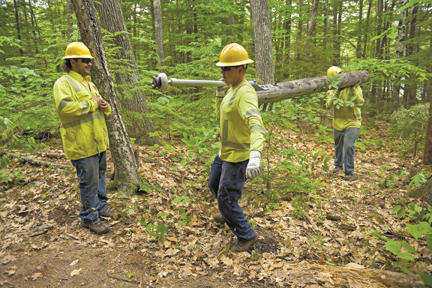
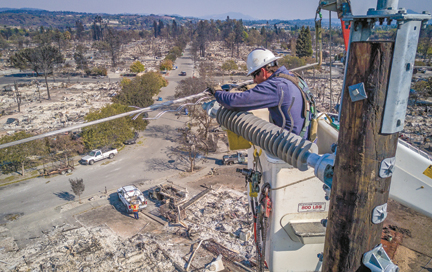
|
| The IBEW now has the resources and ambition for coast-to-coast outside organizing campaigns from the new Boston Local 104 members at JCR to workers like those from Vacaville, Calif., Local 1245 (pictured.)
|
"No one can man all the work. The skills of the linemen have never been in greater demand, and workers have never had more leverage than right now," Oakland said. "It would be crazy to simply match the growth in demand. We have to win market share now."
Throughout the 1990s, utilities spent on average $2 billion a year on transmission and distribution infrastructure. Since 2014, they have spent that much about every month and a half. Industry analysts at the Brattle Group expect that number to be maintained for the next two decades.
"The industry is blowing up. Interest rates are historically low, and the demand is historically high," said Director of Business Development Ray Kasmark. "We expect a 4% growth in demand for linemen every year for the foreseeable future.
"It's simple math. If you want to increase market share, you have to beat that spread between growth and retirement," Kasmark said.
The Old Way — Dying Slowly
Mings was appointed director in 2018 to gain the confidence of the outside locals, hire organizers in the field, set organizing targets and lay out our strategic plan.
For years prior, the outside effort lacked a comprehensive strategy, Mings said. Organizing was scattershot, with Mings handing out business cards and running a social media campaign nearly alone. In many places, the only time a company was organized was when it needed the union to help win a job.
"It was whoever walked through the door for a long time. It was all by chance. That's why we were at 60% market share when I joined in 1978 and we're at 35% now," he said.
Some parts of the country, including Northern Illinois where Mings is from, had traditions of organizing and their market share stayed strong, but for many places, the focus was on replacing the workforce through training apprentices and stripping the occasional worker from a nonunion operation.
"There is simply no way we can do this through apprenticeship and a lineman or two here and there. No way," Mings said. "We have to organize companies into the IBEW or we will disappear."
And it's not that the apprenticeship programs aren't trying.
"We currently have 1,100 outside construction apprentices. That is the most we have ever had," said Mick Van Natta, linemen training coordinator at the Northeastern Joint Apprenticeship and Training Program. The story is much the same at the IBEW's eight other outside training centers.
Set a Strategy. Pick a Target. Execute.
Oakland was given a goal at the 2016 International Convention of 0.5% per year growth by the next convention in 2021. And a new strategy was needed to meet that goal.
Many organizing drives are handled at the local level, but some campaigns need more. Some targets, Oakland said, need additional resources from the international, up to and including full-time international organizers and all-hands-on-deck ground pushes that bring dozens of volunteer organizers from locals across the country for months at a time.
"We are seeing great results with this recipe in other sectors, and it makes sense to bring that same thinking to the outside," Oakland said.
The strategy is relatively simple: Organize so many workers that contractors are forced to accept the IBEW or risk losing their workforce.
"We don't want to go to an election in the construction side of the house," Mings said. "What we are after is voluntary recognition."
Choosing JCR as the first target was almost a no-brainer.
"We started at JCR because the linemen were interested in organizing. They came to us," Mings said. "We had several meetings, and in a bargaining unit of about 150, we had 50 to 90 people showing up."
During the organizing drive, JCR was bought by Quanta, a Texas-based "roll-up" contractor that has purchased about 50 outside electrical contractors in less than decade. With revenue of over $13 billion last year, Quanta are a giant in the industry and, like most of the half-dozen or so similar operations, they have both union and nonunion companies in their portfolio.
"I think that made a very big difference because it wasn't the same longtime owner saying, 'We won't organize.' It was a big company in Texas that owned two other union shops, and these guys had all worked together," Mings said. "When they compared pay stubs with workers from unionized Quanta companies, they could see the difference the IBEW made."
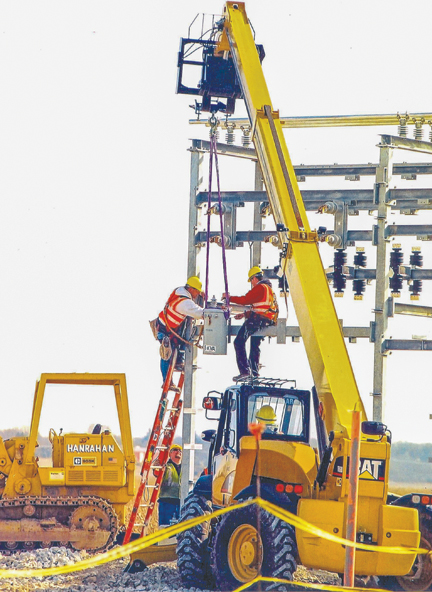
|
| Outside organizing targets include line construction, maintenance and (left) substation work, among other specialties.
|
After collecting enough signed cards from JCR employees, Mings said he and Assistant to the International President for Construction, Maintenance and Business Development Jerry Westerholm went to the leadership of Quanta.
Westerholm has known CEO Duke Austin and founder John Colson for two decades. It wasn't actually Quanta that bought JCR, but a Quanta-owned company, MJ Electric. Mings has known MJ Electric President Ed Farrington for nearly as long. When Westerholm called Austin to tell him they had more than a majority of cards, a long history of mutual respect was an important factor in the company's response.
JCR agreed to voluntarily recognize the new members. At 130 new members, it is one of the largest single construction groups organized, inside or outside, in a long time, Oakland said. And the majority of the credit goes to Boston Local 104.
"They get the kudos. They did the door knocking; they held the meetings. This was their campaign and we helped however we could," Oakland said. "For us, it was a way to shake off the cobwebs."
The next target on Mings' list — the drive that would show the true power of the fully operational organization — was coming, and the target would be a much tougher, much larger Quanta company in one of the most anti-union parts of the nation.
Starting from Zero
If JCR was low hanging fruit, Sumter Utilities in the Carolinas is the opposite.
"We have, effectively, zero market share and none of the linemen there really know who we are. That's not anyone's definition of low-hanging fruit," Mings said.
Sumter Utilities is a Quanta company, and for decades, founder Colson had said to Westerholm that they wouldn't just hand companies over, but they wouldn't play dirty.
"Colson said from the very beginning, 'If you want a group, go after it. If they want to go, they can go.' And, for the most part, Quanta has been living up to it," Westerholm said.
In the case of Sumter, Westerholm went further and negotiated an official neutrality agreement from Quanta. After that, it was time to bring every tool to the campaign.
First, the team got more help. Stephenson appointed the first outside organizer employed by the International, Shannon Davis from Nashville Local 429. Davis had been a utility lineman at a rural electric cooperative fired for trying to organize. Within a few months he was joined by two more new outside organizers: Will Schenk from Tulsa, Okla., Local 1002 and Jason Allison from Kansas City, Mo., Local 53. A fourth, John Harrell from Orlando, Fla., Local 222, was hired in January.
"It won't be structured exactly the same way as inside. We won't have people in every district because the numbers don't justify it," Oakland said. "They will be covering more ground and, because the major contractors work in many places, they'll all help wherever a particular campaign is."
At Sumter, the team reached out to local unions to start planning a ground game, including Charleston, S.C., Local 776, the outside local, and utility locals Charleston Local 398 and Columbia Local 772.
The utility locals knew where the Sumter linemen were, what projects they were working on, where they gassed up in the morning and where they grabbed breakfast. Most of the nonunion linemen don't travel. They work on the grounds of the utility, just like the IBEW utility members. Half of the ground game is knowing where to show up, and Local 398 Business Manager Mark Corn knew where to find them.
"I said, 'Give me a few weeks' notice before you come in, and I can find you where they are going to be working so you can catch them on the jobsites,'" Corn said. "And we could warn them this is coming down the pike. If they see people around and don't know who they are, they're probably IBEW."
Next came the ground push. Once in February and twice in April, nearly 50 organizers from the Construction, Membership Development and Business Development departments, as well as linemen from Grand Rapids, Mich., Local 876 and Columbus, Ohio, Local 71, descended on the Carolinas.
They spread out across dozens of job sites provided by Corn and others and to gas stations and breakfast spots. And they had valuable information like the names and concerns of some of the linemen they'd be talking to.
"I was hoping to show these nonunion linemen that we are here to help, and to let them know we weren't going anywhere," Mings said. "Sumter will take a long, long time. It won't be overnight, and that's our fault. We left that part of the world alone for too long."
That kind of personal connection is crucial in a state as historically hostile to unions as South Carolina. Former Gov. Nikki Haley once announced that she would not allow new unions in the state and would "run out" every union already there.
"It is hard here, very hard here," Corn said. "You have the government pushing back at the state and federal level right now. These workers fear for their jobs. They're afraid to sign cards. They think management is writing down license plates at meetings and, whether it's true or not, they believe it."
Corn told a story about a "safety meeting" that a Sumter foreman called in December. This caught his attention, because he had never seen one called on utility property.
"I was worried someone had died, and I didn't want it to happen on our site," he said. "Well, I go and he was talking about knives and gloves and I'm waiting to hear the big boss talk about the big deal. And then he starts going on about how bad unions are."
Corn stepped into the circle.
"I told him, 'I don't know who you are walking onto my property saying that about my members, but you can turn your bleepity-bleep around and walk right out that gate,'" Corn said. "Well, that spread like wildfire."
As word of the incident (and the utility's refusal to discipline Corn) got around, he got plenty of questions from Sumter workers.
"'Could you talk like that to the boss?' You could if you were union. When they cross the line of the contract, they are wrong and you can tell them so," he said. "Even after that we didn't get a whole bunch of people signed, but they saw something there."
Mings said he calls the campaign a first step.
"Before we got there, hardly anyone was walking into our halls. We stripped hundreds of guys," he said. "How many are still with us is hard to say, but we were hearing from the contractors. They were squawking about all the manpower they lost."


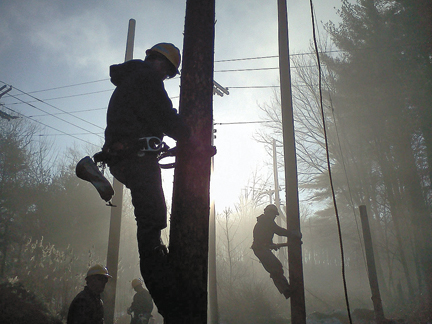
|
| Nonunion line workers often work side by side with IBEW members, especially on storm work. This creates perfect opportunities to talk about the advantages of joining a union without anti-union management stepping in. But organizer Jason Allison cautions that talking paychecks before connecting personally can come across as arrogant.
|
Making a Pitch That Resonates
Outside construction organizer Allison said it was all very familiar to him. From 1997 to 2004 he worked as a nonunion lineman.
"We lived paycheck to paycheck, me and my wife. We were literally budgeting for babies, but we couldn't start a family," he said.
A year after Allison joined the apprenticeship with Kansas City, Mo., Local 53, he and his wife finally started a family even though he was a few years from topping out.
"I knew I would make it. There was no way I was going back," he said.
The message he and the other outside organizers bring to the nonunion linemen isn't complicated, but he has learned that starting out by comparing pay stubs turns many people off. Linemen are proud, he says.
"I start out by asking 'How are they treating you?' These folks sometimes hear 'We make more money' as 'We are better than you,'" he said. "Then I listen. Once they know I care how they are being treated, then we can talk about money."
Allison is now working on Mings' third target, and likely the last before Mings retires this month, Great Southwest, an MYR company. Allison travels all over the Eighth and Eleventh districts, getting cards signed and stripping workers.
"If the company doesn't want to talk to us, we'll strip workers to our side and that brings them to the table pretty quick," he said. "If we see another nonunion company out there, we don't just make a note and drive on; we're stopping."
The Third Side of the Coin
Historically, there have two main ways to organize: bottom up and top down. You organize the workers, or you organize the company. Obviously, when done right, one leads to the other. But this is no longer the whole story.
"Business development is the third side of the coin," Kasmark said. "A contractor needs workers and work. If we can organize the work, contractors have nowhere to go but us."
It also makes Business Development's outside construction representatives — Tiler Eaton and Joel Bell — indispensable resources during ground pushes and organizing drives.
"Joel and Tiler know all the projects on the books for the next 6 to 24 months: where they are, who is doing them and what the opportunities are," Kasmark said. "We can answer linemen's questions and convince a business manager that there is merit in growing."
At the moment, there is so much opportunity everywhere, project owners and contractors are ready and willing to sign on if they get the manpower they need, Bell said.
"Our biggest limitation on organizing right now is that many outside locals don't have the structure to support organizing," he said.
It all comes back, Mings said, to what Stephenson means when he says the IBEW will become an organizing union again. Everyone, everywhere, is back in the game until we meet the goal of the IBEW's founders: organize the whole electrical market.
"We don't have one target, then another, then another. Our target is national. Our resources are sufficient to go after every part of the country," Mings said.
See our video about the JCR Organizing campaign at bit.ly/JCROrganizing